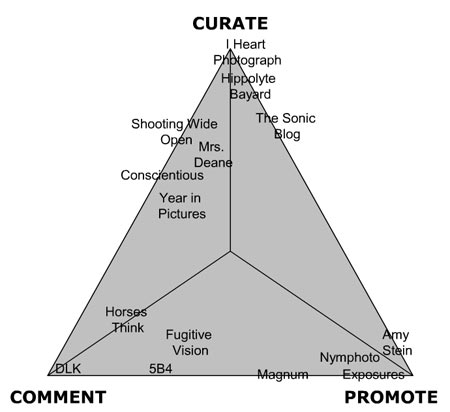The Photo Blog Triangle

A little while ago, the folks over at DLK Collection posted Comment, Curate and Promote: The Art Blog Triangle, which placed art and photo blogs into a triangle with the corners “Comment”, “Curate”, and “Promote”. A blog dedicated entirely to “Promote”, for example, would thus be placed in that corner; one with 50% “Curate” and 50% “Promote” would find itself right in the center of the line that connects those two corners etc. Reading the triangle takes a bit of getting used to, but once you get the basic principle it’s quite instructive. (Here is a description of how this kind of diagram works)
As it turns out, I had been statistics of photo blogs for two months in late 2008. May main reason for doing that was that I wanted actual data to see whether some of the ideas that I or other people have about the state of the (fine art) photo blogosphere was actually correct or not.
For example, a frequent criticism of blogs is that they spend a lot of time linking to each other. I wanted to find out whether that was indeed true or not. And there were other things I was interested in.
So I came up with some categories, and I started to fill them in. I wasn’t really sure what I was going to do with the data - beyond having something tangible to address some of the questions I was interested in. And there certainly was no judgment of any kind involved. There was, however, a lot of work keeping track of everything involved.
But when I saw the The Art Blog Triangle I knew that my data could be used to create a more accurate version of the triangle, where the positions of the blogs would be based on how many posts of each kind they contained in those two months.
While my own categories were different from the DLK ones, translating mine into theirs was straightforward and simple. So I offered the DLK folks my data, and they just published a new version of their triangle, which includes only photo blogs.
Of course, there are all kinds of caveats. One could look at different categories, one could maybe fill my categories differently, the covered period of time could be longer, it doesn’t say anything about the total number of posts, it doesn’t contain all photo blogs, etc. etc. etc. The categories and the way I filled them are based on what I was originally interested in (which is a very common approach in science actually).
Also check the new DLK post for more caveats and a discussion of what the results might mean.
Also the new DLK post is only one way to look at the data - there are plenty of others. And I might even do another survey, taking what I learned into account and trying to do things more smartly.
In any case, what is evident from my data (something that I want to stress here) is that claiming that blogs are mostly linking to each other (the presumed “circle jerk”) is only true for a very small number of blogs. All in all, the photo blogosphere is extremely diverse.